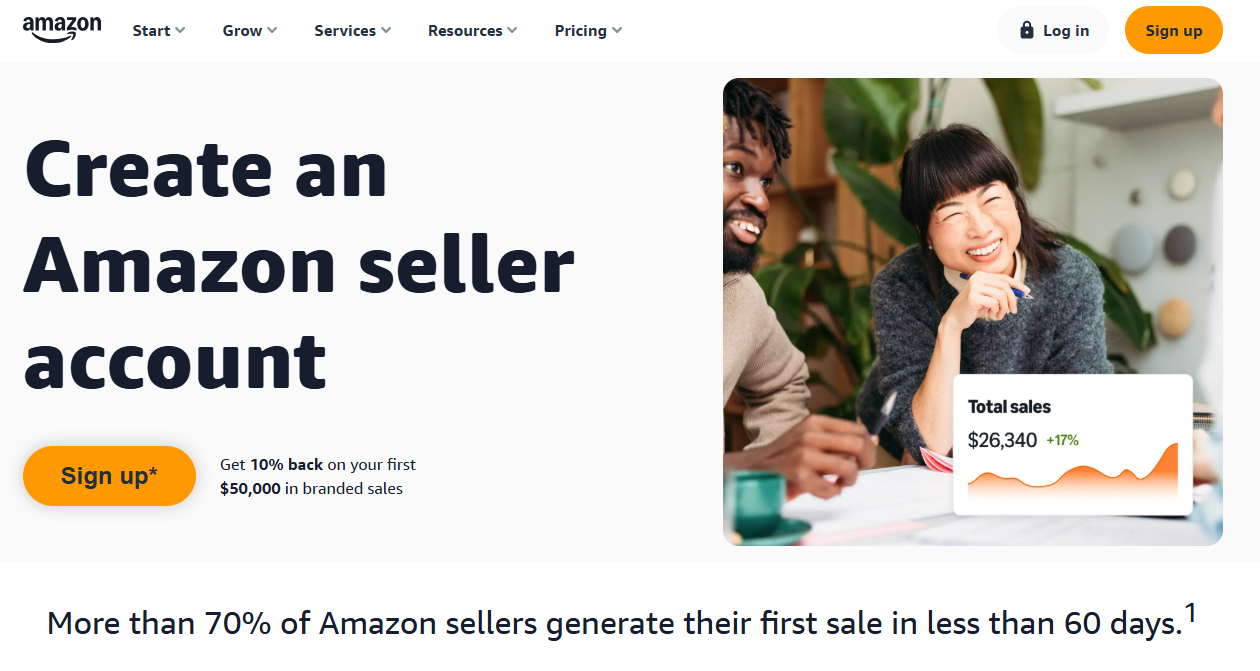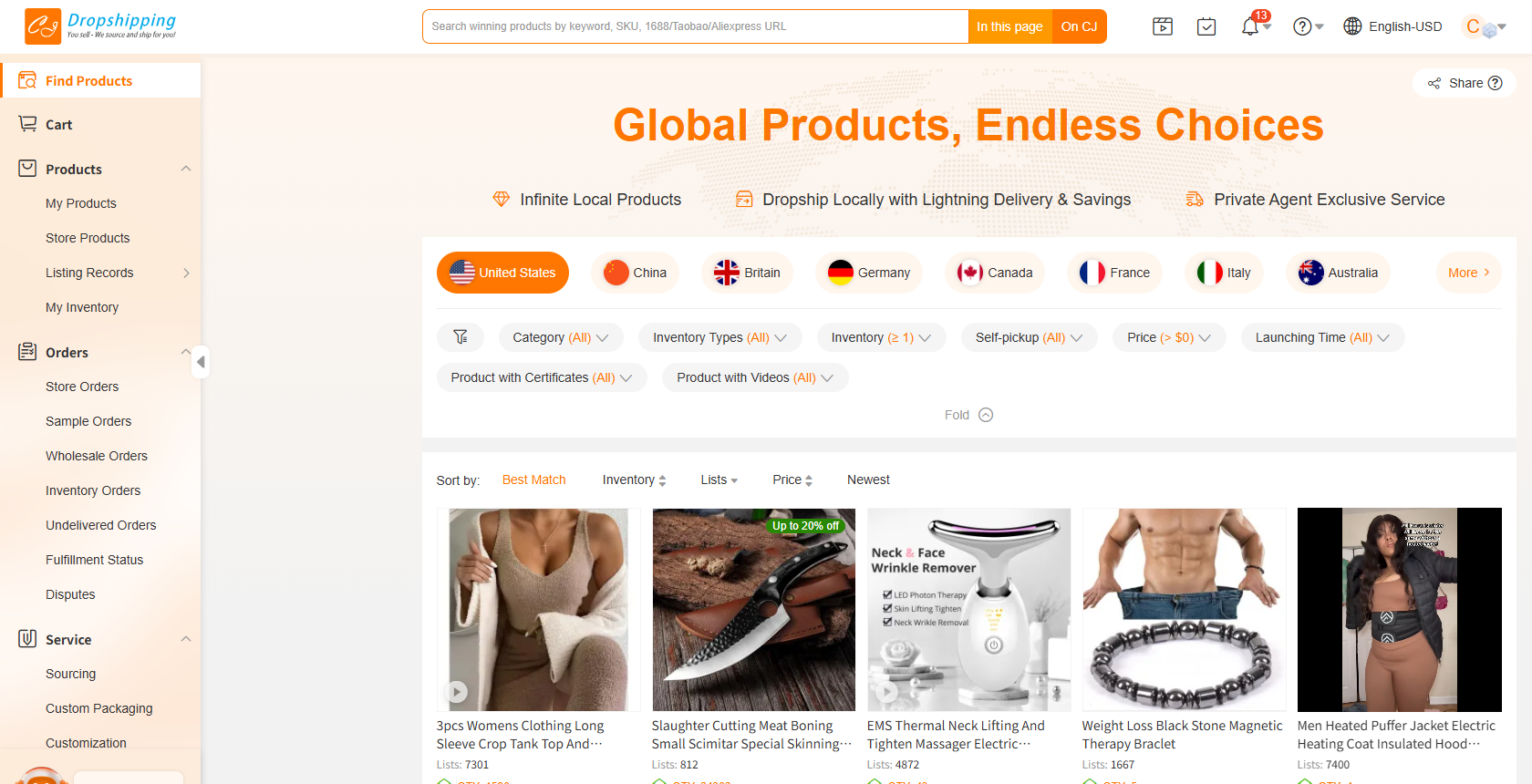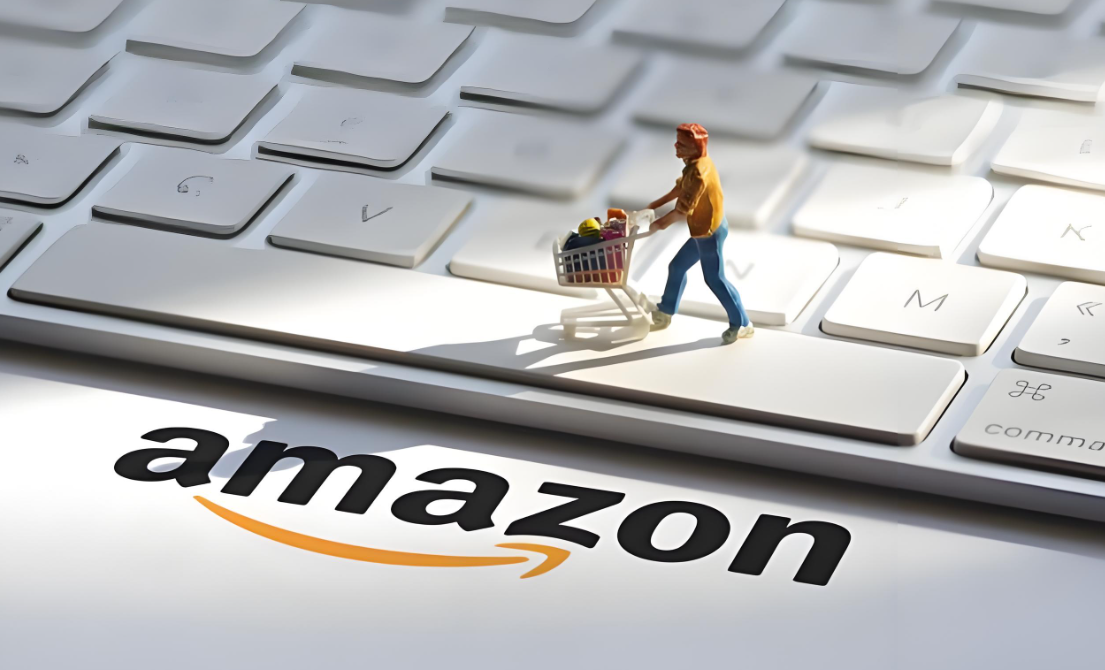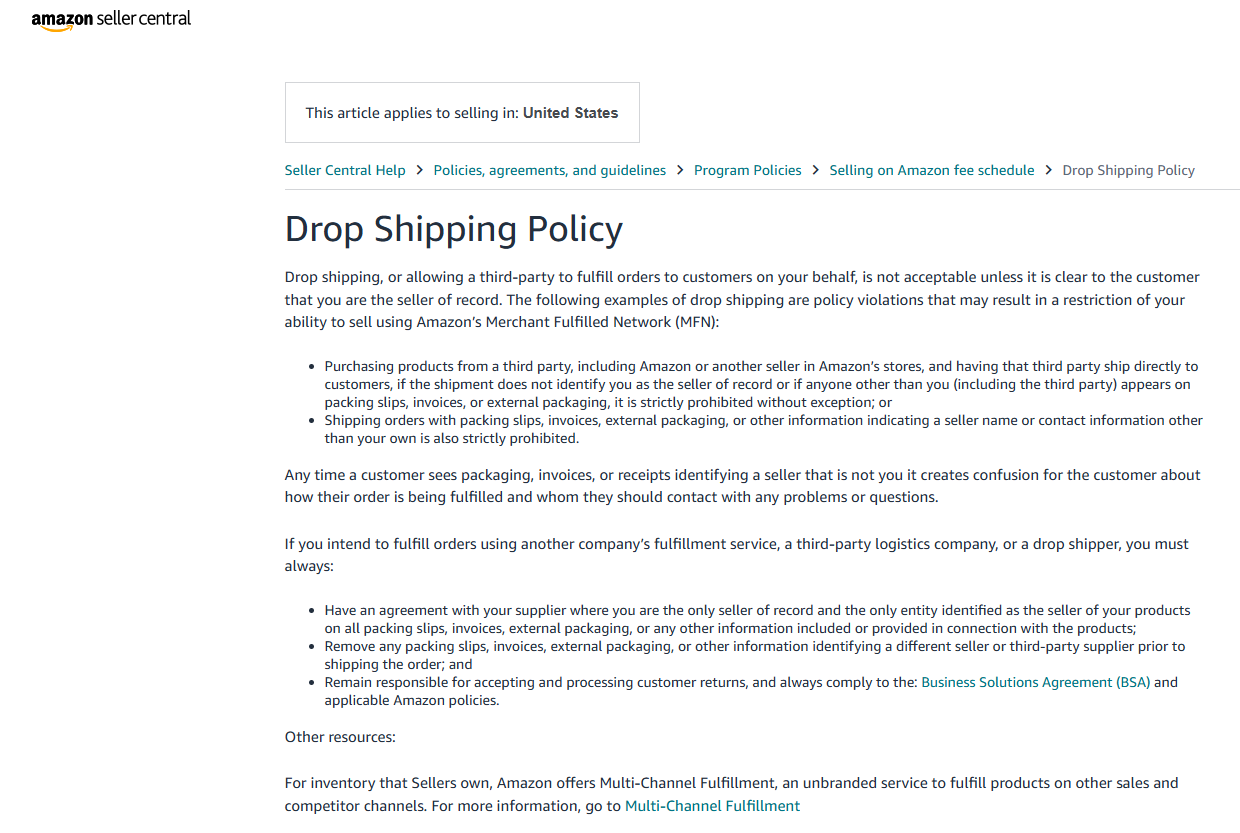Dropshipping is a fulfillment model where you sell products without holding inventory. Instead, when a customer places an order, you (the Amazon seller) purchase the item from a third-party supplier who ships it directly to the customer. This lets you start an ecommerce business with minimal upfront investment. For example, Amazon notes that dropshipping “outsources inventory operations” so you don’t need to buy products before they sell. It’s a popular option for beginners because it avoids storage costs and reduces risk. However, dropshipping also means you have less control over product quality and shipping times, so you must carefully manage suppliers and customer service.
Amazon permits dropshipping if you strictly follow its Drop Shipping Policy. The policy requires that you be the seller of record on all products, and that no packaging or paperwork identifies the supplier instead of you. In practice, this means every box, packing slip, and invoice must list your business as the seller, not the supplier or retailer you ordered from. Amazon explicitly forbids retail-arbitrage dropshipping (for example, buying a product from Walmart or Target to fulfill an Amazon order). If a customer sees another retailer’s branding or packaging, that violates Amazon rules and can lead to suspension. In short: your customer should never see evidence of the supplier – everything must appear to come from you.
Fulfillment Options: FBM vs. FBA
When dropshipping on Amazon, you’ll use the Fulfilled by Merchant (FBM) model, meaning either you or your supplier ship the order directly to the customer. The alternative is Fulfilled by Amazon (FBA), where you purchase inventory and send it to Amazon’s warehouses, and Amazon handles the packing, shipping, and customer service. Amazon summarizes the difference as follows: FBA still outsources fulfillment (Amazon does the shipping/returns), but requires you to buy inventory in advance, whereas pure dropshipping (FBM) lets you pay for products after a customer orders them.
-
Dropshipping (FBM) – No upfront inventory investment. You list the supplier’s products on Amazon, collect payment, then place an order with the supplier who ships to the customer. Startup costs are low, but you must cover shipping (often non-Prime) and keep tight control of fulfillment.
-
Amazon FBA – You buy products in bulk, ship them to Amazon’s fulfillment centers, and Amazon uses its Prime shipping, returns, and customer service. FBA generally costs more to start (you pay for inventory and storage) but can improve margins over time and win the Prime badge.
Many successful sellers mix and match methods. For example, you could test a product via dropshipping (to avoid risk) and if it sells well, stock it with FBA for faster shipping. In fact, Amazon notes that some sellers use FBA for fast-moving items and reserve dropshipping for slower-moving inventory, avoiding long-term storage.
Setting Up Your Amazon Seller Account
1. Register as a Seller.

Go to Amazon Seller Central and sign up. Amazon offers two plans: the Individual plan (no monthly fee, but $0.99 per item sold) and the Professional plan ($39.99 per month, no per-item fee). Most dropshippers choose Professional once they plan to sell more than 40 items/month. During registration, provide the required information:
-
Business Details: Your name, store/display name, address, phone number, and email.
-
Payment & Tax Info: An internationally chargeable credit card, bank account for disbursements, tax information (SSN or EIN), and government-issued ID.
Amazon will verify this information. Be prepared to upload documents (ID, bank statement) if requested.
2. Choose Product Categories.

After account setup, check whether your products need approval. Amazon restricts some categories (e.g. collectibles, music, watches, etc.). Use Amazon’s category and product approval tools: find “Category Overview” or search their approval list to see if your intended products require permission. (For example, collectibles and luxury items often require permission.) If needed, apply for approval to avoid later suspensions.
3. Optimize Your Seller Profile.
Write a clear, professional seller name and bio. Upload your logo, and set up your shipping and return policies. A well-done profile builds customer trust. Amazon suggests adding high-quality images (like a logo) and a compelling seller description so buyers know you’re legitimate.
Finding Products and Suppliers
1.Researching Profitable Products
Success in dropshipping hinges on selecting the right products. Start with market research: look for products with steady demand and decent profit margins. Use tools like Amazon’s Product Opportunity Explorer or third-party analytics to find trending niches. Analyze sales data and competitor listings. For example, SmartScout recommends using data tools to “identify product niches with high demand and low competition”.
When evaluating products, consider profitability. Calculate your costs (product cost + shipping + Amazon fees) versus Amazon’s average selling price for that item. Aim for products where you can set a competitive price and preserve a healthy margin. Keep in mind intense competition can drive margins thin: a high-demand item may have so many sellers that profits shrink. Conversely, niche items might have fewer competitors and higher margins. Use spreadsheet calculators or Amazon’s own revenue calculator to project profits.
2.Here are some of the best free product research methods
CJdropshipping YouTube Channel & Blog
– Find expert insights and trending product recommendations.

Monitor Amazon Best Sellers & Movers & Shakers
– Check the Best Sellers page for top-selling items in your niche, updated hourly.
Conduct Keyword & Search Term Analysis
– Utilize Amazon’s own autocomplete suggestions by typing seed keywords and noting the drop‑down list.
Analyze Customer Reviews & Q&A Sections
– Read reviews on related products to learn what features buyers love or wish were improved.
Tap into Google Trends & Social Media Signals
– Use Google Trends to compare search interest for product ideas and spot seasonal or viral surges.
– Track platforms like TikTok, Instagram Reels, and Pinterest for emerging product virality, then cross‑reference them on Amazon.
Amazon recommends some categories for dropshipping, like clothing, electronics, or pet supplies, but warns to avoid items with special handling needs. Specifically:
-
Avoid perishable or fragile goods. Since you can’t control storage conditions, skip food, temperature-sensitive, or hazardous items.
-
No customization during shipping. Standard dropshipping means products ship straight from supplier. If you want to insert freebies or personalized notes, dropshipping may not allow it.
Choosing Suppliers (AliExpress, CJdropshipping, etc.)
Once you know what to sell, find reliable dropshipping suppliers. Popular platforms include:
-
AliExpress. A huge Chinese marketplace with millions of products at wholesale prices. AliExpress is favored by many dropshippers for its low costs and free shipping deals. The downside is longer shipping times (especially to the US/Europe) and variable quality. To use it safely, pick sellers with high ratings and many orders, and communicate before selling. AliExpress also offers a Dropshipping Center (free tool) and apps like DSers to streamline product import and order fulfillment.
-
CJdropshipping. A China-based dropshipping service that emphasizes fast processing. CJ can warehouse products in its own facilities and handle shipping with its own logistics. They offer product sourcing, order automation, and custom packaging options. Notably, CJ can even buy from other suppliers on your behalf, inspect and repackage goods, then ship under your name. In effect, CJ acts as a “middleman” that can help you comply with Amazon’s seller-of-record requirement: it purchases from manufacturers, then ships from CJ’s warehouses, ensuring packages show only your brand. This can be a lifesaver if your original supplier won’t remove their branding. Keep in mind CJ and similar services often charge per-item fees or monthly plans for dropshipping features.
-
Other platforms: Solutions like Spocket, Oberlo (for Shopify), SaleHoo, Worldwide Brands, or even direct Alibaba suppliers with dropshipping support are options. Many dropshippers mix sources. For example, you might test products on AliExpress, then switch to CJ or local suppliers for faster shipping. Always vet suppliers: look at their ratings, request samples if possible, and ensure they support “blind shipping” (no invoice or supplier info in package).
Validating Suppliers and Products
Regardless of platform, follow these tips:
-
Check reviews and ratings. On AliExpress/CJ, read buyer feedback. A 4.8+ seller rating and thousands of orders is a good sign.
-
Communicate clearly. Message suppliers before ordering. Ask if they do blind dropshipping (no branding), what their lead times are, and how they handle returns. This gets them on record and shows if they’re responsive.
-
Order samples. Whenever possible, buy a sample for yourself. Check product quality, packaging, and shipping speed. This is the best way to avoid selling poor-quality goods.
-
Monitor stock levels. Dropshipping means you don’t control inventory. Use software or manually watch your supplier’s stock. Sync your listings so you don’t oversell. Many sellers set up automated alerts for low stock.
A well-vetted supplier relationship is gold: trusted suppliers reduce delays and defects, keeping your Amazon metrics healthy (see below).
Listing Products on Amazon

With products and suppliers lined up, it’s time to create your Amazon listings.
-
Product Titles: Craft clear titles that include key details (brand, model, size, color, etc.) and relevant search keywords. For example: “Wireless Bluetooth Headphones with Noise Cancellation – Over-Ear, Black”. Use major keywords early, but keep titles readable.
-
Bullet Points & Description: Use bullet points to highlight features and benefits (e.g., “Up to 20 hours of battery life,” “Comfort-fit design with adjustable headband”). In the longer description, expand on details and secondary keywords. Remember Amazon’s SEO guidelines: a descriptive listing helps customers and boosts visibility. For instance, one source advises using the description to mention additional keywords and elaborate on product benefits.
-
High-Quality Images: Include multiple clear photos (white background plus lifestyle shots). Show the product from different angles, in-use examples, or scale. Because you won’t touch the product, make sure your supplier’s images look professional. If possible, add your own images or infographics to improve quality.
-
Pricing: Research competitors’ prices for the same item. Your price must be competitive and cover all costs (supplier cost + shipping + Amazon referral/fulfillment fees). A common tactic is to price slightly below top competitors to win the Buy Box, but automated repricers (discussed later) can help you stay optimal. Amazon offers a free Automate Pricing tool that lets you set rules (like “stay 5% below lowest competitor”) and will adjust your price 24/7. This helps you remain competitive without manual work.
Here’s a quick checklist for each listing:
- Write clear, benefit-focused bullet points and description.
- Incorporate relevant keywords naturally in the title and description.
- Use high-resolution images (Amazon requires at least 1000×1000 px for zoom feature).
- Set a competitive yet profitable price. If dropshipping margins are thin, you may need to target slightly higher-priced or niche items.
- Ensure your listing adheres to Amazon’s style guidelines (no excessive punctuation, etc.).
Once live, you can also create promotions or coupons to attract buyers. Consider enrolling your products in advertising (Sponsored Products) to boost visibility if you have budget. But at first, focus on optimizing the listing itself.
Fulfilling Orders and Customer Service

When a customer buys your listing, act quickly: immediately place the order with your supplier and pay for expedited shipping if possible (to keep customers happy). Communicate with the supplier to confirm the order, and obtain tracking information. Enter the tracking number into Seller Central promptly. Amazon penalizes late shipment and invalid tracking, so be diligent here.
Key steps in the order process:
-
Forward Order to Supplier: Once the sale is made, purchase the item from your supplier, providing the customer’s shipping details. Many automation tools (AutoDS, SparkShipping, etc.) can do this in one click.
-
Ensure Proper Packaging: Remind the supplier to use neutral packaging. Per Amazon’s policy, the box must show only your branding (or plain) – no supplier logos, marketing inserts, or invoices identifying a third party. If the supplier isn’t already set up for blind shipping, you may have to ask them to remove any branded slips or even use a repackaging service (CJ can do this).
-
Monitor Shipment: Track the order until delivery. Make sure the supplier ships with a reliable carrier and provides a valid tracking number. Input that tracking in Seller Central so the customer can see it.
-
Customer Communication: Keep the buyer informed. Send them a polite email (via Amazon’s buyer-seller messaging) confirming order receipt and shipment tracking once available. If any delays occur, proactively notify the customer through Amazon’s messaging system. Good communication prevents negative feedback.
-
Handling Returns/Support: You are responsible for any returns or issues. If a customer wants a refund or has a defective item, you must resolve it — either by refunding yourself or coordinating with the supplier for a replacement. Amazon expects you to process returns in line with its policies. For example, if a customer claims an item never arrived, you must refund or replace it immediately even though you didn’t ship it yourself. In practice, keep some reserve fund or use Amazon’s reimbursement programs to cover these scenarios.
Amazon warns that dropshippers must have a customer service plan that “meets or exceeds Amazon’s policies”. This means you should have clear handling times (be honest with shipping estimates on your listing), a fair return policy (often same as Amazon’s), and fast responses to buyer inquiries. Missing these can hurt your metrics.
Amazon Dropshipping Policies

Know the rules. Amazon’s Drop Shipping Policy lays out the dos and don’ts. Here are the essentials:
-
Seller of Record: You must always appear as the seller. All packing slips, invoices, and external packaging must identify your business, not the supplier. This includes not using any generic invoice that reveals a wholesaler’s name.
-
Remove Third-Party Info: Before shipping, you must strip any mention of the supplier. No third-party logos, branding, or advertisements in the box. If the supplier’s name is on a receipt, remove it. Amazon’s guidance: if a customer sees another retailer’s tag in the package, you’ve violated the policy.
-
Handle Returns: You’re responsible for returns and refunds. Make sure you have a process (even if that means requesting the supplier ship to you first) so you can issue refunds quickly. Always follow Amazon’s return policies.
-
Follow All Amazon Terms: All other parts of the seller agreement still apply (deliver on time, no counterfeit products, etc.).
What’s prohibited: The biggest no-no is “retail arbitrage” dropshipping. That means buying from an online retailer (like Walmart, Target, or even buying on Amazon itself) and having that retailer ship the product to your customer. Amazon specifically calls out this practice as forbidden, even if the customer is satisfied, because it violates the seller-of-record rule.
“In short, Amazon is okay with you using a supplier, but your customer should have no idea that supplier exists.”. Always vet your suppliers accordingly.
Staying compliant is non-negotiable. Violating the policy (even by accident) can get your listing removed or account suspended. For example, if a supplier occasionally includes their business card in the box, that could trigger a violation. To be safe, tell suppliers to never include any of their paperwork. It’s worth double- or triple-checking packages at the supplier if you can.
Avoiding Common Mistakes
Even careful dropshippers slip up. Here are common pitfalls and how to avoid them:
-
Selling out-of-stock items. If you list a product that your supplier runs out of, you’ll end up canceling orders. High cancellation rates hurt your account health. Tip: Always sync inventory. Use software to automatically pause your Amazon listing when the supplier’s stock hits zero.
-
Underestimating shipping time. Many new sellers promise unrealistically fast delivery. If your supplier needs 10–20 days to ship from China, set your Amazon handling time accordingly (e.g. 3–4 days) and be clear with customers. It’s better to under-promise and over-deliver.
-
Neglecting Amazon’s metrics. Amazon tracks performance relentlessly. Key metrics to watch are Late Shipment Rate (LSR), Order Defect Rate (ODR), and Pre-Fulfillment Cancellation Rate. Aim for LSR < 4%, ODR < 1%, and cancellations < 2.5%. Poor metrics are a fast route to suspension. If a supplier is causing late shipments or defects, switch suppliers immediately.
-
Inaccurate tracking info. Always provide valid tracking numbers. Fake or invalid tracking is a red flag. Double-check tracking after shipment and update Amazon.
-
Not following up with customers. If a buyer has a question or issue, respond promptly (within 24 hours). Friendly, helpful service reduces negative feedback. Remember, even though you don’t physically ship the item, you are the merchant in the customer’s eyes.
By staying vigilant about these areas, you protect your account health. As Doba’s guide notes, suspensions are usually preventable with the right processes. In summary: play by the rules, deliver on your promises, and track your performance.
Maintaining Account Health
Your Amazon Account Health Dashboard will show key figures like ODR and LSR. Maintain them below Amazon’s targets to avoid penalties. Here are best practices:
-
Set Realistic Handling Times: If your supplier takes 2–3 days to process orders, don’t promise 1-day shipping on Amazon. Setting conservative handling times avoids late shipments.
-
Monitor Performance Metrics: Regularly check Order Defect Rate (ODR), Late Shipment Rate (LSR), Pre-Fulfillment Cancel Rate, and any customer feedback. Aim for ODR < 1% and LSR < 4%. If you’re approaching those limits, pause sales or find a faster supplier.
-
Respond Quickly to Issues: If a buyer contacts you or an Amazon A-to-Z claim is filed, respond immediately. Proactively resolving issues (refunds, replacements) will often prevent a defect from even registering.
-
Quality Control: If possible, inspect at least first shipments yourself or have the supplier do a quality check. Fewer defective products = happier customers = better ratings.
-
Avoid Policy Violations: Keep up with Amazon announcements. For instance, if a policy changes (as it did in 2021 with stricter packaging rules), adapt quickly.
Your goal is to keep a high seller rating. Over time, this leads to more visibility (Buy Box preference) and trust from shoppers.
Scaling Your Dropshipping Business
Once your basics are solid and you’ve proved a product sells, look to scale:
-
Add More Products: Gradually increase your catalog. Don’t list hundreds of items at once; expand methodically by adding 5–10 new listings per week. Use what you learn about profitable niches to guide expansion.
-
Enter New Markets: Consider selling on other Amazon marketplaces (e.g. Amazon.ca, .uk, .de). The dropshipping process is the same, but remember import duties and shipping rules may differ.
-
Leverage FBA for Winners: As mentioned, transitioning best-sellers to FBA can unlock Prime customers and reduce Amazon fees per unit. Start by shipping small batches of your top items to Amazon while continuing to dropship slower movers.
-
Diversify Suppliers: Don’t rely on a single supplier or product. If one source gets cut off, you’ll want alternatives. Explore local or domestic suppliers to speed shipping for certain products.
-
Improve Your Brand: Over time, think about private labeling or customizing products that are selling well. Even simple changes (different color or bundled gift packaging) can distinguish your listings.
-
Build an Omni-Channel Strategy: Many dropshippers also sell on eBay, Etsy, or their own Shopify stores. This can spread risk. For example, if Amazon traffic dips, sales on your own site can pick up the slack.
Scaling also means automating. Manual order-by-order dropshipping is fine for a handful of sales, but once you’re doing dozens a day, use software to handle routine tasks (see below).
Tools and Automation
To run efficiently and profitably, incorporate tools wherever possible:
-
Product Research Tools: As noted, software like Jungle Scout, Helium 10, and SellerApp can analyze Amazon’s market data, track competitors, and find winning products. For example, Jungle Scout’s Product Tracker shows historical sales/price data for ASINs, helping you predict demand. These tools help you prioritize high-potential products and keyword opportunities.
-
Listing Management: Apps like AutoDS or Easync can bulk-import products from AliExpress/CJ and even write listings for you. They can also sync your inventory so if a supplier runs out, your Amazon listing goes inactive automatically.
-
Order & Inventory Automation: Platforms such as Spocket, Ordoro, CJdropshipping, or SparkShipping integrate Amazon with suppliers. They automatically forward orders to suppliers, update tracking numbers on Amazon, and adjust stock and prices in real-time. For example, CJdropshipping highlights features like automatic product importing, real-time inventory sync, and order forwarding, which remove much of the manual work.
-
Repricing Software: Since Amazon is a competitive marketplace, tools like Amazon’s own Automate Pricing (free) or third-party repricers (RepricerExpress, Feedvisor, etc.) can keep your prices competitive 24/7. These tools adjust your offer to match (or beat) other sellers according to rules you set, helping you win the Buy Box and sales without constant monitoring.
-
Customer Service Tools: Use saved replies in Amazon Seller Central for common questions to speed up responses. You might also use analytics (like Amazon’s business reports) to spot which products get frequent complaints (then address the issue).
-
Financial Tools: As sales grow, accounting gets tricky. Consider software like QuickBooks or specialized Amazon accounting tools to track expenses, profits, and taxes, so you always know which products are truly profitable.
Remember: any tool should integrate seamlessly with Amazon Seller Central. Many offer free trials – test a few to see which fits your workflow and budget.
Best Practices and Tips
-
Focus on Niche, Quality Products: Generic, ultra-competitive items (like basic phone chargers) often require razor-thin margins to compete. Consider targeting sub-niches or bundles (e.g. “wireless charger + phone stand kit”) to stand out.
-
Optimize Continuously: Track which keywords bring customers to your listing (via Amazon Brand Analytics or Seller Central reports) and refine your listing accordingly. Revisit your listings every month to tweak bullets, add A+ Content if eligible, or adjust prices based on seasonality.
-
Excel at Customer Service: The quality of service makes a huge difference. Always ship items (via your supplier) as promised, and follow up after delivery to thank customers and gently request a review. Handle complaints gracefully – even a refund or replacement can earn you a positive review if done right. Treat Amazon like a partnership: good customer experience sustains your business long-term.
-
Stay Educated: Dropshipping rules and marketplace trends change. Join Amazon seller forums or communities (e.g. the Amazon subreddit, Seller Forums) to learn from others. Follow Amazon’s official Seller Blog for updates (like this one!) on policy or feature changes.
-
Maintain Ethical Standards: Never plagiarize listing content, use fake reviews, or circumvent Amazon’s systems. Trust takes years to build and seconds to lose. Ethical selling ensures your account stays in good standing.
Conclusion
Starting a dropshipping business on Amazon can be a lucrative way to enter ecommerce with minimal upfront risk. By understanding Amazon’s rules, carefully selecting products and suppliers, and setting up efficient processes, even beginners can build a sustainable dropshipping operation. Remember to monitor your metrics, adapt quickly to issues, and always put the customer first. With consistent work, good suppliers, and smart use of tools, you can grow from one product to a full catalog, possibly integrating FBA or your own store down the road.
Dropshipping isn’t a get-rich-quick scheme—it requires attention to detail and compliance—but for many entrepreneurs it offers a flexible, scalable way to sell on the world’s largest marketplace. Follow the steps above, avoid the common pitfalls, and keep learning. Good luck on your Amazon dropshipping journey!
